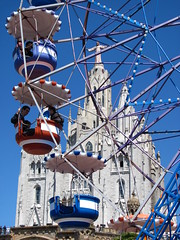 Barcelona, Spain – Saturday, May 15th, 2010
Barcelona, Spain – Saturday, May 15th, 2010
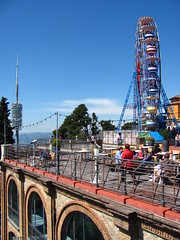 As I stepped off the funicular railway that carried me to the apex of Tibidabo a few minutes before 11:00am, I knew time would be of the essence. My time would be limited to a little under three hours to get to fully experience what had been one of my most anticipated amusement parks in Europe. Rationally I knew it was a small park and that would still be more than enough time to check everything off my list and then some, but Tibidabo always appeared to be a place where a strictly rational assessment would be fundamentally missing the point. Perhaps that was why it was so high on my list.
As I stepped off the funicular railway that carried me to the apex of Tibidabo a few minutes before 11:00am, I knew time would be of the essence. My time would be limited to a little under three hours to get to fully experience what had been one of my most anticipated amusement parks in Europe. Rationally I knew it was a small park and that would still be more than enough time to check everything off my list and then some, but Tibidabo always appeared to be a place where a strictly rational assessment would be fundamentally missing the point. Perhaps that was why it was so high on my list.
To my knowledge Tibidabo is the only full-sized historical amusement park that remains in operation in Mediterranean Europe.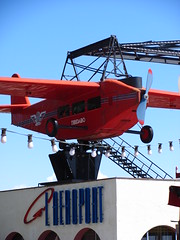 Weird to consider, but Monte Igueldo is better classified as a smaller FEC type park with one uniquely historical ride built in the center of it, Italy’s oldest roller coaster is the 1985-opened Magic Mountain, Paris’s Jardin d’Acclimatation didn’t seem to become designated as a rides park until sometime in the late 1980’s (odd given Paris’ involvement in the original development of pleasure gardens and gravity railways in the 1800’s), and Greece’s eight entries in the RCDb are carnival coasters installed post-2000. This makes Tibidabo a special, one-of-a-kind place: it exists neither with the geographically proximate modern theme parks which form the rest of the market in southern Europe, nor does its flavor quite resemble the similar Anglo, Germanic or Scandinavian parks which are still sprinkled around the northern half of the continent. Carved into the side of a mountain overlooking the city, some rides include a rotating observation arm tower from 1921 where you stand in a tiny hot-air balloon basket 1500 feet above sea level, and a 1928 airplane ride set over the side of a cliff where its only means of power is a set of real propellers. It’s places like that are the reason for traveling in the first place, right? To encounter new forms of understanding the world via different cultural and historical
Weird to consider, but Monte Igueldo is better classified as a smaller FEC type park with one uniquely historical ride built in the center of it, Italy’s oldest roller coaster is the 1985-opened Magic Mountain, Paris’s Jardin d’Acclimatation didn’t seem to become designated as a rides park until sometime in the late 1980’s (odd given Paris’ involvement in the original development of pleasure gardens and gravity railways in the 1800’s), and Greece’s eight entries in the RCDb are carnival coasters installed post-2000. This makes Tibidabo a special, one-of-a-kind place: it exists neither with the geographically proximate modern theme parks which form the rest of the market in southern Europe, nor does its flavor quite resemble the similar Anglo, Germanic or Scandinavian parks which are still sprinkled around the northern half of the continent. Carved into the side of a mountain overlooking the city, some rides include a rotating observation arm tower from 1921 where you stand in a tiny hot-air balloon basket 1500 feet above sea level, and a 1928 airplane ride set over the side of a cliff where its only means of power is a set of real propellers. It’s places like that are the reason for traveling in the first place, right? To encounter new forms of understanding the world via different cultural and historical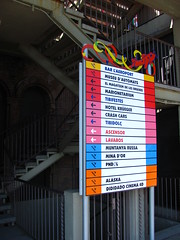 contexts in ways that disclose meaning to us?
contexts in ways that disclose meaning to us?
In spite of those ideals my experience started off remarkably similar to a day at Cedar Point, the chain dropping at eleven where a minor running of the bulls ensued to the major new rides, backtracking several times with crumpled map in tow trying to figure out how to get from Level 6 to Level 3 (Tibidabo is also perhaps the only park in the world whose maps provide directionality to attractions along the X, Y and Z axes). I quickly made it to be in the front row of the day’s second cycle of the Tibidabo Express powered roller coaster. If it weren’t for the fact that it uses the car and track system identical to other steel coasters, the layout for this one would be better classified as a particularly speedy train ride with some rather abrupt turns and seemingly no gravity-driven portions (some might exclude counting it as a coaster for that reason). A custom layout through some rather dense landscaping and a dark tunnel along the first major turn made it a worthwhile attraction, and they send you around more than once.
Before moving along to some of the larger rides the Castell Misteriós caught my attention, so I quickly opted to give this walk-through fun house the once-through. Low lighting along uneven, seemingly improvised corridors and stairways made dioramas of ghouls and warlocks all the more creepy precisely because they were cheap and artificial looking. Plus it was amusing watching the Spanish youth scream and scamper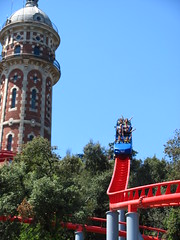 past the airblast ducts and bull horns, which were particularly abrasive and shocking compared to any American-built walk-throughs I’ve done.
past the airblast ducts and bull horns, which were particularly abrasive and shocking compared to any American-built walk-throughs I’ve done.
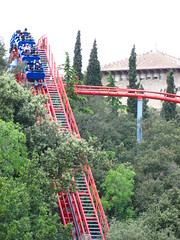 From here I turned around and made my way back along the lowest level to the area where the parks newest and biggest rides are located, where I wasted little time in getting to Tibidabo’s new starring attraction, the Muntanya Russa (not a misspelling of the Spanish “Montaña Rusa” but rather the Castilian form of the same name; while to me Castilian seemed to be minor variations of a phonetically spelled Spanish, I learned on my previous day’s tour that it actually shares a much closer
From here I turned around and made my way back along the lowest level to the area where the parks newest and biggest rides are located, where I wasted little time in getting to Tibidabo’s new starring attraction, the Muntanya Russa (not a misspelling of the Spanish “Montaña Rusa” but rather the Castilian form of the same name; while to me Castilian seemed to be minor variations of a phonetically spelled Spanish, I learned on my previous day’s tour that it actually shares a much closer linkage to French, Italian and Latin). Immensely pleased was I to discover this 2008-built Vekoma attraction was running both trains efficiently despite it not being an especially crowded day. On my first ride in the back
linkage to French, Italian and Latin). Immensely pleased was I to discover this 2008-built Vekoma attraction was running both trains efficiently despite it not being an especially crowded day. On my first ride in the back row I was seated with an older Spanish gentleman who was clearly a long-time patron of the park and seemed extraordinarily pleased he could share a ride with a first timer visiting from a far ways away. Although I couldn’t even determine if our conversation was held in Spanish or Castilian, his obvious enthusiasm for the ride as he narrated the entire experience to me communicated far more than I imagine some of my own reviews do for readers with the same language.
row I was seated with an older Spanish gentleman who was clearly a long-time patron of the park and seemed extraordinarily pleased he could share a ride with a first timer visiting from a far ways away. Although I couldn’t even determine if our conversation was held in Spanish or Castilian, his obvious enthusiasm for the ride as he narrated the entire experience to me communicated far more than I imagine some of my own reviews do for readers with the same language.
 Indeed there was quite a lot to be enthusiastic about. Despite its modesty as a gentle, family-accessible attraction, Vekoma managed to produce one of the best roller coaster experiences with this endlessly fun, smooth, and delightful ride whose integration with the park’s steep terrain while removing a minimal amount of trees let it fit like a glove to a park that would otherwise seem resistant to modern steel investments. The turn at the top of the first lift has us looking down the side of the mountain at the rest of the city and coastline of Barcelona laid out below us, where it speedily dips into a ground level left curve, some scant airtime even noticeable in the
Indeed there was quite a lot to be enthusiastic about. Despite its modesty as a gentle, family-accessible attraction, Vekoma managed to produce one of the best roller coaster experiences with this endlessly fun, smooth, and delightful ride whose integration with the park’s steep terrain while removing a minimal amount of trees let it fit like a glove to a park that would otherwise seem resistant to modern steel investments. The turn at the top of the first lift has us looking down the side of the mountain at the rest of the city and coastline of Barcelona laid out below us, where it speedily dips into a ground level left curve, some scant airtime even noticeable in the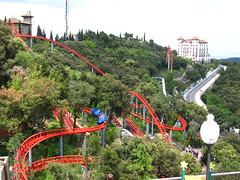 back row. Despite this fantastic opening act the layout only gets better from here, greeting us with a wily series of terrain-hugging switchback s-curves between the trees and adjacent supports. Something about this nimbly paced slalom track was cause for an inducement of giggling not achieved on any other modern steel coaster I’ve been on, it was almost as if we had stopped riding a roller coaster and started dancing a tango. Priceless.
back row. Despite this fantastic opening act the layout only gets better from here, greeting us with a wily series of terrain-hugging switchback s-curves between the trees and adjacent supports. Something about this nimbly paced slalom track was cause for an inducement of giggling not achieved on any other modern steel coaster I’ve been on, it was almost as if we had stopped riding a roller coaster and started dancing a tango. Priceless.
From here the ride unfortunately loses most of its groove as the final switchback into a long left turnaround leads into a shallow, drawn out camelback which acts as little other than a breather from the laugher. The second half is comparatively conventional although it still has good terrain interaction;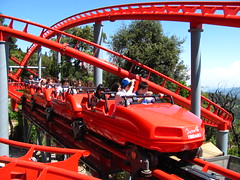 a right turn set inside the opposing first curve feeds a long, straight transition into a downward final helix. This is my only point of criticism of the layout, as a ‘final helix’ is a bit too obvious a solution to cap their layout off with, and in this case it’s both lacking in character and force such that it finishes the dance on a flat note. I won’t take too much fault out on anyone though, given the limited land and difficult terrain. Not that some minor but effective adjustments couldn’t have been made, such as increasing the radius to get more force and angular momentum out of it, or possibly even extending it into a double downhill helix. As it stands it was still a better coaster than those in the majority of Spain’s big theme parks, and shows how far a bit of extra care can take a simple design.
a right turn set inside the opposing first curve feeds a long, straight transition into a downward final helix. This is my only point of criticism of the layout, as a ‘final helix’ is a bit too obvious a solution to cap their layout off with, and in this case it’s both lacking in character and force such that it finishes the dance on a flat note. I won’t take too much fault out on anyone though, given the limited land and difficult terrain. Not that some minor but effective adjustments couldn’t have been made, such as increasing the radius to get more force and angular momentum out of it, or possibly even extending it into a double downhill helix. As it stands it was still a better coaster than those in the majority of Spain’s big theme parks, and shows how far a bit of extra care can take a simple design.
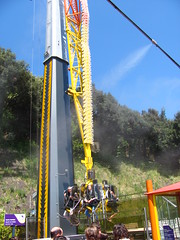 I made use of the short queue and dispatches every minute or two by grabbing a handful of five or six rides on the Muntanya Russa before moving on down the midway to see what else might be worth my while. The Mina d’Or appeared a fairly prototypical and somewhat small scale log flume, and as it was posting a longer line I decided to skip it. At the far end of this walkway was the Pndol, an exceedingly bizarre ride that I at first thought was one of their vintage home-made contraptions but upon closer inspection I realized it to be a relatively new invention from Fabbri. Two large independent arms are attached to a tower, one motorized, the other free swinging and holding passengers. The motor arm would latch onto the passenger arm,
I made use of the short queue and dispatches every minute or two by grabbing a handful of five or six rides on the Muntanya Russa before moving on down the midway to see what else might be worth my while. The Mina d’Or appeared a fairly prototypical and somewhat small scale log flume, and as it was posting a longer line I decided to skip it. At the far end of this walkway was the Pndol, an exceedingly bizarre ride that I at first thought was one of their vintage home-made contraptions but upon closer inspection I realized it to be a relatively new invention from Fabbri. Two large independent arms are attached to a tower, one motorized, the other free swinging and holding passengers. The motor arm would latch onto the passenger arm,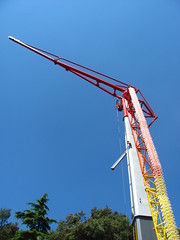 pushing slowly it up to the top of the circumference, where it would then disengage and let the passenger arm swing freely back and forth while the seats flip forward and backward until friction eventually brings it back to a halt.
pushing slowly it up to the top of the circumference, where it would then disengage and let the passenger arm swing freely back and forth while the seats flip forward and backward until friction eventually brings it back to a halt.
If this doesn’t like a particularly intuitive or even safe device, that’s because it isn’t: two months later Tibidabo made international news headlines when the ride collapsed, killing one young passenger while injuring the rest. While at the time it seemed unfortunate that ability to carry only four riders at a time (coupled with a very long ride cycle) made the prospect of getting a ride with even a queue of only forty people impossible on my time schedule, looking back it was most definitely for the best that more people weren’t able to fit in the car at once. Maybe with its removal and the need for something happy and positive to fill the void they’ll build a compact terrain wooden coaster from the Gravity Group in its place. (Hey, we all like to dream, don’t we?)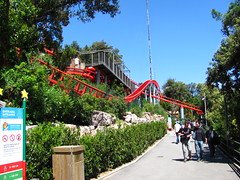
In the end I just turned around and decided to get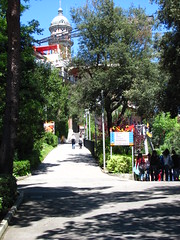 more rides in on the Muntanya Russa, then turning my sights to rides further up the mountain. In many ways Tibidabo reminded me of a European version of Kennywood. The urban setting mixed with dramatic terrain and plenty of natural foliage; the quirky historic rides and eclectic ambiance that can only come from decades of growth and fine-tuning under the leadership of differing, unique visions; as well as the integration of pre-1940’s long-time favorites with a post-1970’s-to-present expansionary period. I would definitely be one to call this a good comparison, and a reminder of the disappointment over my limited time.
more rides in on the Muntanya Russa, then turning my sights to rides further up the mountain. In many ways Tibidabo reminded me of a European version of Kennywood. The urban setting mixed with dramatic terrain and plenty of natural foliage; the quirky historic rides and eclectic ambiance that can only come from decades of growth and fine-tuning under the leadership of differing, unique visions; as well as the integration of pre-1940’s long-time favorites with a post-1970’s-to-present expansionary period. I would definitely be one to call this a good comparison, and a reminder of the disappointment over my limited time.
In a covered area inside one of the stacked levels of the park was another indoor haunted walk-through attraction named the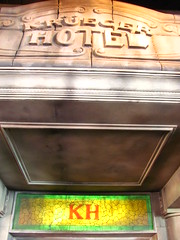 Krüeger Hotel. Alas, another low throughput also rendered this one with a longer than necessary wait, but after skipping the previous two I wanted to wait it out. While it ended up robbing a precious hour of a three-hour visit, I’m still mostly glad I did as it was probably the best permanent walk-through haunted houses I’ve been to. The doorman greeting patrons had plenty of fun with his role, not that he was going to let us see it. At one point while waiting he pretended to let a group in, but stopped the rest short tricking the nervous girl in the lead to enter without realizing her friends weren’t behind her. She tried to re-exit but he insisted she go in alone, taking her hand to lead her in with him. After a moment of silence a scream was heard. The doorman then reemerged alone, carrying the girl’s bag with a bloodied severed hand sticking out of it.
Krüeger Hotel. Alas, another low throughput also rendered this one with a longer than necessary wait, but after skipping the previous two I wanted to wait it out. While it ended up robbing a precious hour of a three-hour visit, I’m still mostly glad I did as it was probably the best permanent walk-through haunted houses I’ve been to. The doorman greeting patrons had plenty of fun with his role, not that he was going to let us see it. At one point while waiting he pretended to let a group in, but stopped the rest short tricking the nervous girl in the lead to enter without realizing her friends weren’t behind her. She tried to re-exit but he insisted she go in alone, taking her hand to lead her in with him. After a moment of silence a scream was heard. The doorman then reemerged alone, carrying the girl’s bag with a bloodied severed hand sticking out of it.
The house itself had many very accomplished set pieces and was filled with actors who took their roles just as seriously as the doorman. While I couldn’t keep up with the story being told, important was the fact that there actually was a story told throughout the entirety of the walk-through, and not just a random series of scare gags with maybe one monologue at the beginning like at every American Halloween event I’ve ever been to. The sets were in many cases quite eerie and haunting (and varied) even when nothing ‘scary’ was happening… which anyone at all familiar with a good horror movie knows empty silence is ten times more frightening than the nastiest of nasties rearing their face directly in front of you. (Although I’d argue the best horror movies don’t even go for any form of thrills, they just leave you with an empty existential dread that haunts you for the next week or two; I’d like to make a haunted house or dark ride that does the same someday.) Then the scares do come, and like a good European attraction there were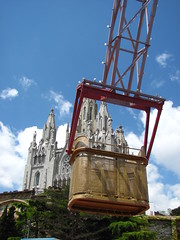 many startling close encounters that would qualify for “never in America” status. Again, half the joy was being led through with a group of locals who had clearly much more anxiety towards what was around the next corner than I.
many startling close encounters that would qualify for “never in America” status. Again, half the joy was being led through with a group of locals who had clearly much more anxiety towards what was around the next corner than I.
Nearly fifteen minutes after entering the Krüeger Hotel I once again saw daylight… and shit, I’ve got not much more than 45 minutes left before I said I needed to be back on the funicular on my way to Barcelona Sants train station. Time to start hustling and getting the last ‘must do’s’ checked off my list. This involved returning to the upper level and attending to the vintage observational rides where the thrill comes from wondering if the spindly iron structures will spontaneously blow over in the wind while you’re on them. This began with the Talaia, the previously mentioned 1921-built ride with two baskets attached to either end of a large, continuously rotating arm. Thankfully despite what would have been a low throughput I found no one else was in line so I was able to walk right on, sharing my cycle with a lone, young Spanish woman, where we enjoyed a pleasant conversation between taking in the sights (as well as taking some photographs of said sights…)
The nearby Panoràmic ferris wheel was also tempting me with a ride, but I needed to prioritize my time and accordingly made the iconic Avió airplane ride my next target. This one took a bit longer before I could climb on board (surprisingly no full-body scanners were needed), and when I did I was greeted with what appeared to be the interior of an authentic 1920’s passenger plane straight out of The Aviator, including on-board washroom. The propellers start up and the plane slowly starts its movement around the large sweep. The views offered of the park and the city are spectacular, just make sure you get a seat on the right side of the plane. After it completes the first rotation the motor cuts off and it lets the momentum carry it around a second cycle, upon which they gently bring it to a stop back at the loading platform. If ‘thrills’ are defined as g-forces then Avió is quite possibly the least thrilling ride I’ve ever been on. However, to even contemplate defining such a ride experience in only such terms would only be an exercise in idiocy. Avió is thrilling because it is such an exceedingly rare sort of ride experience, and there’s a sense of enormity of scale when in its presence: enormity of the panoramic vistas, enormity of the history each steel bolt and leather seat contains, and enormity of the mechanisms themselves, at least when considering that this entire enclosed cabin that swings out at least 100 feet above the next cliff level still operates using the same simple, singular technology since 1928.
around the large sweep. The views offered of the park and the city are spectacular, just make sure you get a seat on the right side of the plane. After it completes the first rotation the motor cuts off and it lets the momentum carry it around a second cycle, upon which they gently bring it to a stop back at the loading platform. If ‘thrills’ are defined as g-forces then Avió is quite possibly the least thrilling ride I’ve ever been on. However, to even contemplate defining such a ride experience in only such terms would only be an exercise in idiocy. Avió is thrilling because it is such an exceedingly rare sort of ride experience, and there’s a sense of enormity of scale when in its presence: enormity of the panoramic vistas, enormity of the history each steel bolt and leather seat contains, and enormity of the mechanisms themselves, at least when considering that this entire enclosed cabin that swings out at least 100 feet above the next cliff level still operates using the same simple, singular technology since 1928.
Now I was risking tardiness, and when you have a train to catch, you can’t be just a ‘little bit late’. Collecting my backpack I found the funicular and was the first one to board. Then we waited for more people to trickle on board, then we waited, then the tram filled to capacity, and then we waited a little bit more, just to make sure I worked up a decent sweat. The ride back down was easily the most thrilling of the entire day– I kept checking my watch with a cold pit of realization that by the time I got to the nearest Metro station there was no way I’d be able to make the transfer to Barcelona Sants before 3:35.
As soon as we landed at the bottom of the mountain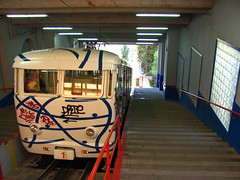 I took off like a bolt, running the rest of the way down the winding grade to get to the lowest point where the Metro system once again reached. But then I’d have to take a stop for a breather. Then I’d remember how I was only ten seconds late to Vidámpark, and took off running again. Then I’d stop for another breather, remembering that I have a heart condition and I could literally die in the middle of this street in Spain. Then I realized if I missed this train I’d be as good as dead anyway, so I kept running until my veins pumped battery acid. Then I ran some more.
I took off like a bolt, running the rest of the way down the winding grade to get to the lowest point where the Metro system once again reached. But then I’d have to take a stop for a breather. Then I’d remember how I was only ten seconds late to Vidámpark, and took off running again. Then I’d stop for another breather, remembering that I have a heart condition and I could literally die in the middle of this street in Spain. Then I realized if I missed this train I’d be as good as dead anyway, so I kept running until my veins pumped battery acid. Then I ran some more.
But was there even a point? It was already 3:10 and I had to make at least two transfers. It would be a miracle even if I didn’t have to do any waiting on the platform. Thankfully at the plaza in front of the metro station were parked a few cabs, and the prospect of collapsing in an air conditioned vehicle and being whisked directly from here to the front steps of the train station meant I didn’t even stop to think of the €20- €30 I’d be spending on fare. Well, not more than two seconds, at least.
My attempts to communicate the urgency of haste to the cabby were limited to stuttering through asking, “¿Cuánto tiempo hasta… um, Barcelona Sants?”
“Quince a veinte minutos.”
“Ahhh… okay. Gracias.”
I arrived with seven minutes to spare, a luxury compared to my prayed for five. I entered the station and… JEEZUS FRICKING CHRIST, THIS PLACE IS HUGE! I ran one way, realized I was not getting closer to my platform, then hurried the other, which was equally dead ended.
“You’ve got three minutes left to find your train – stop running, just ask! Helluva lot less difficult.”
Apparently the high speed AVE trains depart from an underground lower level, and I would have to go through a security checkpoint to get there. A sign pointed me to the platform number I wanted, it was right at the bottom of this escalator. As I approached I thought I could hear a whistle blow. Shit – double time it down those stairs! Move! Move! MOVE!
An attendant at the bottom of the platform saw me and my obvious haste and enthusiastically encouraged me for this final leg. The train was still there, they checked my ticket and welcomed me aboard, and I found my seat and collapsed. A minute of idleness later a businessman entered the train and found his seat nearby, calm as a Hindu cow. For a moment I really wanted to see his guts roasted as I still wiped sweat from my brow. The train shut its doors and took off thirty seconds later. In five and a half hours I would arrive on the northern coast of Spain in San Sebastián for what was to be my final night in continental Europe.
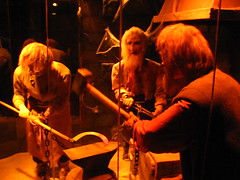








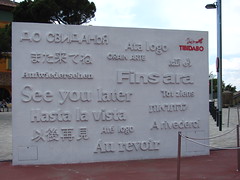
Comments